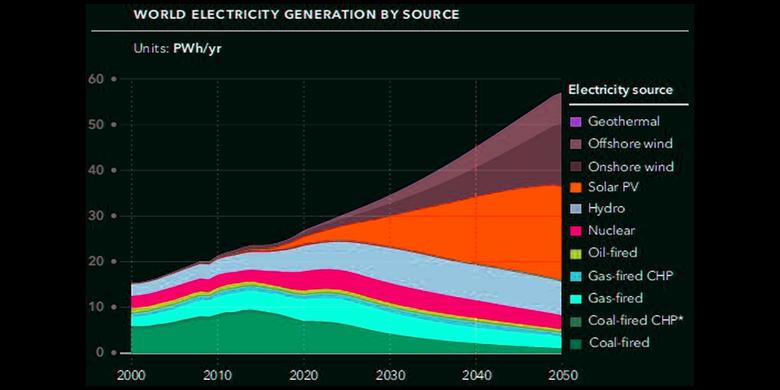
GLOBAL RENEWABLE ELECTRICITY UP 20%

U.S. EIA - According to the U.S. Energy Information Administration’s (EIA) International Energy Outlook 2019 (IEO2019), global electric power generation from renewable sources will increase more than 20% throughout the projection period (2018–2050), providing almost half of the world’s electricity generation in 2050. In that same period, global coal-fired generation will decrease 13%, representing only 22% of the generation mix in 2050. EIA projects that worldwide electricity generation will grow by 1.8% per year through 2050.
EIA projects that total world electricity generation will reach nearly 45 trillion kilowatthours (kWh) by 2050, almost 20 trillion kWh more than the 2018 level. Although growth occurs in both OECD and non-OECD regions, the growth in electricity demand in non-OECD regions far outpaces those in OECD regions. Even though electricity demand growth contributes to a region’s fuel share of generation, the scale and scope of that region’s policies provide different incentives and play an important role as well.
Throughout the projection period, some regions have high electricity demand growth, some have aggressive emission reduction policies, and some have relatively little change in both. Varying demand growth and policies across regions lead to different distribution of fuel shares for electricity generation within each region. However, the power sector’s share of generation from renewables tends to increase and the share of coal tends to decrease.
India has the most rapid regional electricity demand growth (4.6% per year) in the IEO2019 Reference case. Although India has developed target levels for solar and wind capacity, it does not have an aggressive emissions reduction policy in place, so EIA projects coal-fired generation growth in addition to growth in solar and wind generation. Combined, solar, wind, and coal will account for 90% of India's electricity generation mix in 2050. Combined wind and solar generation increases from less than 10% of India's generation mix in 2018 to more than 50% of the generation mix in 2050. The level of coal-fired generation increases during that same time period, but coal’s share of India's electricity generation mix falls from about 75% of the mix in 2018 to less than 40% in 2050.
New capacity additions for renewable technologies are economically competitive with fossil technologies worldwide. But without policy incentives, growth in generation from renewable sources is limited in regions with slow demand growth. OECD Europe electricity demand is projected to grow at about 1% per year through 2050; however, EIA expects that a regional carbon dioxide cap will contribute to a reduction in fossil-fired generation and an increase in renewables generation to meet demand. Throughout the projection period, EIA expects that the share of wind and solar generation in OECD Europe will increase from 20% to almost 50% by 2050. In that same period, EIA projects that fossil-fired generation will decrease from about 37% to 18% of the generation mix. By 2050, coal-fired generation comprises only 5% of the region’s generation mix.
With annual demand growth slower than 1% and no firm policies aimed at reducing carbon dioxide emissions, the mix of generation resources in the non-OECD Europe and Eurasia region (which excludes Russia) will change only marginally. Through 2050, wind and solar generation increases marginally and accounts for less than 10% of the generation mix in 2050, leaving hydroelectric power as the main source of renewables generation for this region. Growth in natural gas generation will displace some coal-fired generation—which falls from 31% in 2018 to 15% in 2050—but the overall share of fossil generation will change relatively little throughout the projection period.
-----
















